7.5.2 Identification of Fragrances
Fragrances/perfumes provide a “Holy Grail” for GC-MS analysis. As noted in many movies or from a trip to a European fragrance shop (perfumery), a near infinite variety of combinations of fragrances can be made. In this laboratory exercise, “name brand” fragrances will be compared to their more inexpensive counterparts in an effort to determine if a difference exists in their “fingerprint” based on GC-MS. A fingerprint, in this context, is a characteristic chromatogram of a complex mixture of compounds.
Perfumes consists of (1) primary scents at the parts per million concentration, (2) modifiers that alter the primary scent to give the perfume a certain desired character, (3) blenders (ingredients that smooth out the transitions of a perfume between different bases; top, middle, and base notes of a fragrance may have separate scents), and (4) fixatives (natural or synthetic substance used to reduce the evaporation rate).
Sources of primary scents include: (1) Plant sources (bark, flowers and blossoms, fruits, leaves and twigs, resins, roots, rhizomes and bulbs, seeds, woods, (2) Animal sources (Ambergris which are lumps of oxidized fatty compounds, Castoreum from the odorous sacs of the North American beaver, Civet Musk obtained from the odorous sacs of the animals related to the Mongoose, Honeycombs, Musk originally derived from the musk sacs from the Asian musk deer), (3) and 0ther natural sources (extracts of lichens and seaweed). Synthetic sources of the natural compounds mentioned above are used today, as well as calone, linalool and coumarin from terpenes, and salicylates (orchid scents) are also used today.
Experimental Procedures
Chemicals and Supplies:
-
A variety of perfume samples can be analyzed. In this experiment, Light Blue by Dolce and Gabbana, Shades of Blue by Belcam, Drakkar Noir by Guy Karoche, Classic Match by Belcam, Unforgivable by Sean John, Unjustified by Belcam, and Bring It by Parfums were used.
GC-MS Settings:
-Capillary Column: DB-5: Poly(phenylmethyldimethyl) siloxane (5 % phenyl)
30 m x 0.25 mm; 0.25 mm phase coating
-Injection Volume: 1.00 mL
-Split Mode of Injection
-Split Flow Rate: 131 mL/min.
-Column Flow: 1.3 mL/min.
-Linear Velocity: 42 cm/s
-Injector Temperature: 250 C
-Detector Temperature: 230 C
-Quadrupole Temperature: 150 C
-Oven Program: Initial Temp. at 40.0 C for zero minutes, 2.0 C to 280 C, hold for five minutes.
-Total Run Time: 125 min.
Procedures:
Analyze a variety of perfume samples on a GC-MS using the instrumental conditions given above.
Results:
(1) The relatively expensive “Light Blue” and a generic blend “Shades of Blue”:
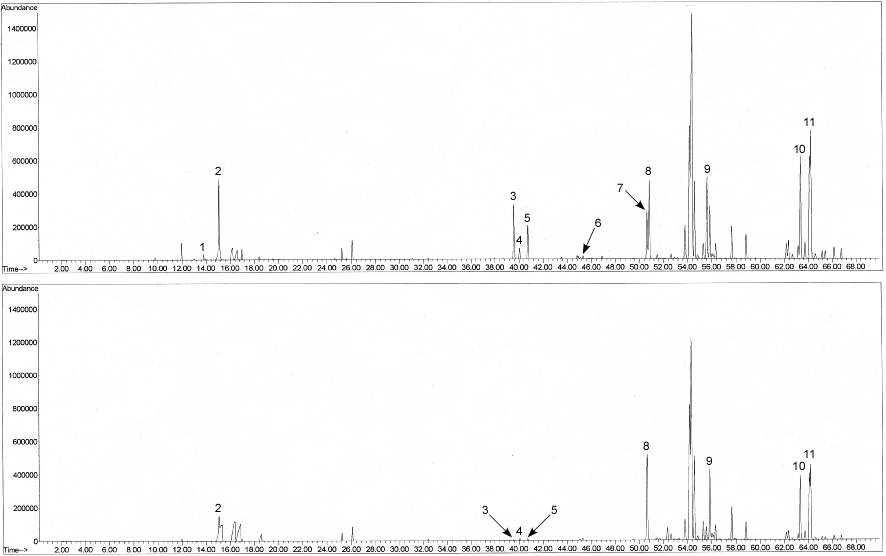
Figure 7-22. Chromatogram of Light Blue (top figure) and Shades of Blue (bottom figure).
Note the presence, absence, or reduced concentrations of the components between the two perfumes. Names and chemical structures for the numbered components are given in the following table.
Table 7.5. Labeled Components in Chromatograms of Light Blue by Dolce & Gabbana vs Shades of Blue by Belcam.
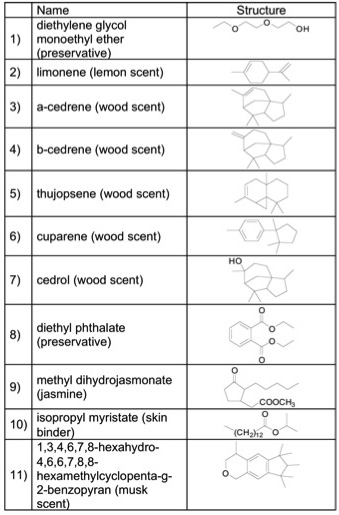
(2) Drakkar Noir and the generic “Classic Match”:
Drakkar Noir is a blend of citrus, lavender, spices and woods. Top notes are citrus, middle notes are woody and herbaceous and base notes are woody warmed and spiced with aromatic coriander and juniper berries, strengthened by sandalwood, patchouli and fir balsam.

Figure 7-23. Chromatogram of Drakkar Noir (top figure) and Classic Match (bottom figure).
Table 7.6. Labeled Components in Chromatograms of Drakkar Noir and Classic Match.
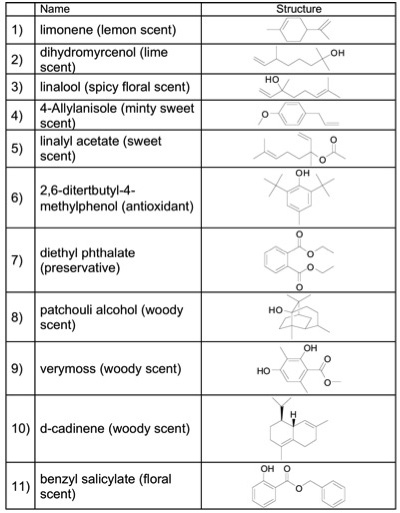
(3) Unforgivable by Sean John vs Unjustified by Belcam Inc. vs Bring It by Parfums de Coeur
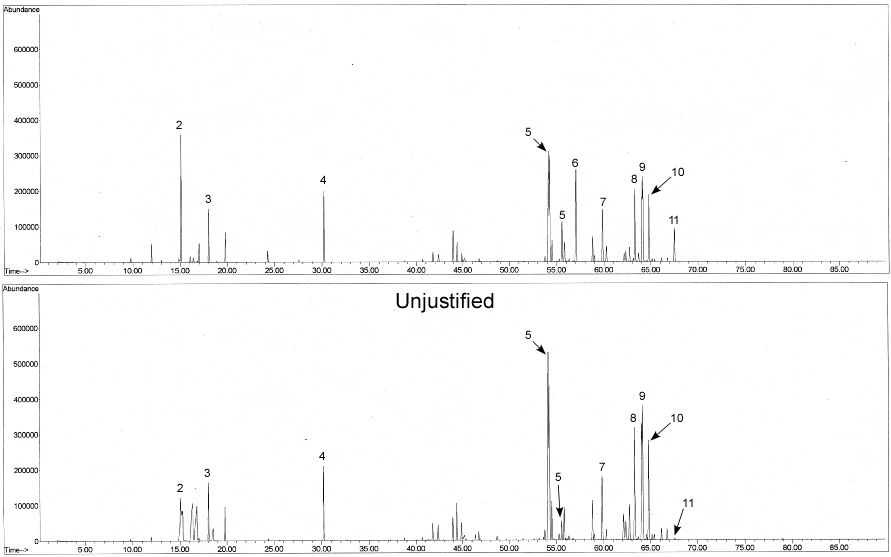
Figure 7-24. Chromatogram of Unforgivable (top figure) and Unjustified (bottom figure).

Figure 7-25. Chromatogram of Bring It.
Table 7.7. Labeled Components in Chromatograms of Drakkar Noir and Classic Match.
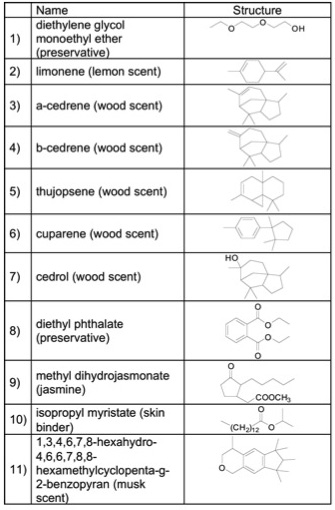
Comparisons of the “real” versus “fake” perfumes show distinct similarities with respect to presence of peaks and their “fingerprint”. However, closer inspection of each peak shows differences. These subtle differences change our olfactory perception of their “smell”. Note the identification of the components in each table and the type of the compounds present and their purpose.
| Frank's Homepage |
©Dunnivant & Ginsbach, 2008